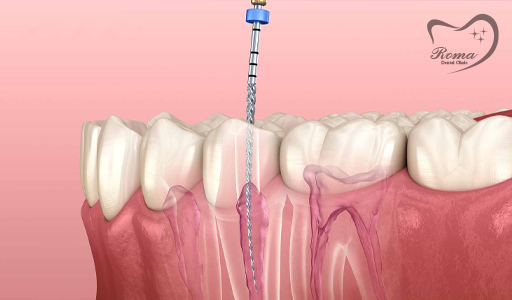Root canal therapy

The steps of endo (root therapy)
The endo procedure is such that the dentist first completely numbs the area around the tooth. He then cuts the decayed part of the tooth to access the tooth pulp. If the pulp and root of the tooth are infected, it completely drains the infection. After that, the root canal cleans the tooth well and fills the inside of the canals with the help of files. The size of the selected files depends entirely on the tooth canal.
The dentist usually fills the tooth temporarily afterwards to prevent germs from entering the root of the tooth. If there is no problem for the patient, he removes the dressing and fills the tooth with permanent materials. Since the strength of denervated teeth is less than other teeth, it is better to use veneers to increase tooth strength after endodontic treatment. One of the most important benefits of using veneers is to increase the strength of restored teeth and also the natural appearance of teeth.
When is endo (root canal treatment) needed?
Tooth decay is clearly visible most of the time. In this case, it is better to go to the dentist to repair the caries. If you do not repair these caries if you see them, the caries will deepen and involve the root of the tooth. However, in some cases, caries may start on the side of the teeth and you may not be able to detect it in time. In this case, see a dentist if you notice any of the following symptoms. Because these symptoms are the main signs of tooth decay and pulp damage.
- Tooth sensitivity to hot and cold foods is one of the earliest signs of root damage.
- When you chew hard food, you get severe toothache and shooting.
- You have persistent and unbearable toothache.
- You will see tooth decay on the tooth surface.
- Your gums are swollen.
- Tooth color is darker than other teeth.
- Swelling on your cheek and on the side of the damaged tooth.
The cause of denervated tooth infection
- Dentist made a mistake in emptying the dental canals and leaving the infection in the dental canal
- Use of substandard and non-standard materials that cause rapid filling of filling materials and tooth infection.
- Improper denervation, which allows bacteria to enter the root of the tooth and eventually cause a tooth infection.
- Smoking immediately after root canal treatment
- The presence of gum disease and its lack of treatment before endodontic treatment
- Lack of attention to oral health
- Restored tooth walls may break due to the large amount of caries. For this reason, it is best to cover the teeth no later than one year after root canal treatment.
- Excessive consumption of sugary substances such as soft drinks and sweets
- If you put a lot of pressure on the tooth after restoration. For example, open the glue door with your teeth. Or break the skin of pistachios and hazelnuts with the help of teeth.
- The presence of decayed teeth around restored teeth and their infection
- Ignoring the doctor’s recommendations immediately after tooth restoration


